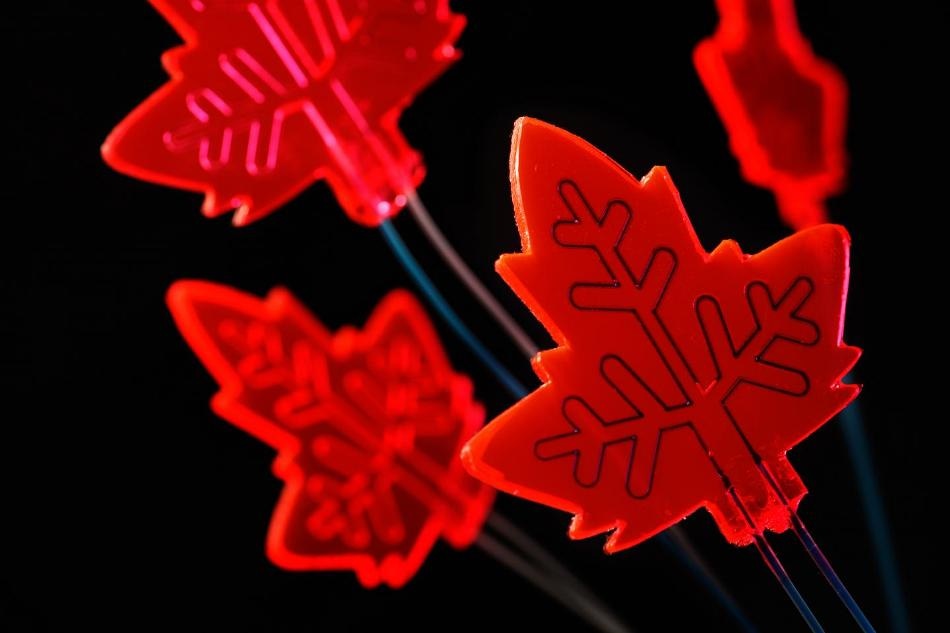Apr 25 2018
Sustainable and economical production of, for instance, medicines could perhaps be possible with the aid of sunlight. The 'mini-factory' in the shape of a leaf that was showcased by chemical engineers from the Eindhoven University of Technology in 2016 has made this a reality.
 Even with the naked eye the amount of light captured by the 'mini-factories' is visible, lit up bright red. The 'veins' through the leaves are the thin channels through which liquid can be pumped. The start products enter the one channel, light causes the reactions and the end product comes out via the other channels. (Image credit: Bart van Overbeeke)
Even with the naked eye the amount of light captured by the 'mini-factories' is visible, lit up bright red. The 'veins' through the leaves are the thin channels through which liquid can be pumped. The start products enter the one channel, light causes the reactions and the end product comes out via the other channels. (Image credit: Bart van Overbeeke)
At present, the Eindhoven researchers demonstrate an improved version: their 'mini-factory' is currently capable of keeping production at the same level, regardless of any variation in sunlight on account of time of the day or cloudiness. Consequently, this increases the average yield by almost 20%. This is because of a clever feedback system costing less than 50 euros that automatically decelerates or accelerates production. This has removed a major practical barrier for green reactors that work only on sunlight.
With their ‘artificial leaf’ the team, under the guidance of the Eindhoven chemical engineer Timothy Noël, gained a lot of respect about a year and a half ago. First, they were successful in making chemical reactions possible with sunlight—something that had formerly seemed virtually impossible. Chemists had envisaged this likelihood for years, but the issue was that the amount of sunlight was not adequate.
Their innovation can be partially attributed to the use of comparatively new materials (so-called luminescent solar concentrators) that seal in a particular part of the sunlight inside, in a similar manner as plants do using the distinctive antenna molecules in their leaves. The second discovery was to apply very thin channels in these materials, through which liquids can be pumped thus exposing the liquids to enough sunlight to allow chemical reactions to occur. The final products then flow out at the extremities of the channels.
Problem: Not Always the Same Amount of Sun
One of the biggest practical difficulties to apply this on a large scale is that there is no continuous intensity of sunlight. The sky can get cloudy or the sunlight differs in intensity and composition during the day.
If there is too much light, you get unwanted by-products and if there is too little light, the reactions do not take place or do so too slowly. Ideally, the system should automatically adapt to the amount of incoming sunlight.
Timothy Noël
The feedback system created does precisely that. It comprises just three fairly simple elements. A light sensor is designed to measure the quantity of light that reaches the channels. A microcontroller converts this signal to a pump speed. The pump then drives the fluids via the channels at that speed. All this costs not more than 50 euros. Experiments to establish the required pump speed for a particular light intensity enabled the researchers to improve the feedback loop.
Test on the Roof
Besides lab testing under artificial light, they also tested their system on top of the roof of one of the buildings on the TU/e campus in natural sunlight. At a yield setting of 90%, the system maintained production steady for an hour at between 86% and 93%. The same system without feedback looping differed greatly between 55% and 97%. The average yield was boosted by about 20% owing to the feedback loop.
According to Noël, this brings an economical and sustainable reactor significantly closer to being able to create chemical products on a large scale, wherever it is required, with purely sunlight as an energy source. "It is inevitable that energy prices will rise. And with a source of energy like the sun that is free and available, these kinds of technological solutions can make the difference."
Artificial leaf as mini-factory for medicine
Reference
Fang Zhao, Dario Cambié, Volker Hessel, Michael Debije and Timothy Noël, Real-time reaction control for solar production of chemicals under fluctuating irradiance, Green Chemistry 2018, 24 April 2018 [DOI: 10.1039/c8gc00613j]